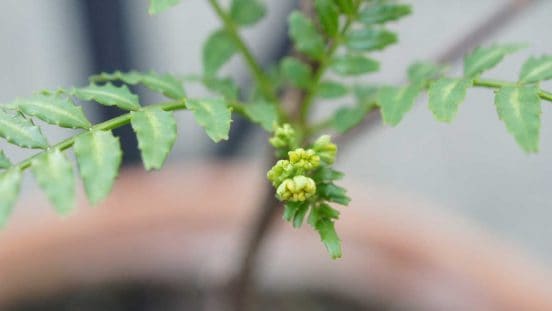Sichuan pepper (huajiao) as a spice is often labeled as Zanthoxylum piperitum – which is Japanese pepper, sanshou.

It is not only a matter of academic concern.
It matters if you are interested in understanding, and using, the diversity of Sichuan peppers and Japanese pepper.
Species and Ranges
The source of the problem seems to be that Japanese pepper is Zanthoxylum piperitum, and it is (or was) the most available and well-known of these “peppers.”
It did not help matters that the range of this species was not well understood. Zanthoxylum piperitum L. (DC.) was assumed to grow from Japan via Korea into China, including the Himalayas.
More recent sources, first of all the Flora Chinas, find 41 species of Zanthoxylum in China (25 of them endemic, i.e. not existing anywhere else) – but not Z. piperitum.
Apparently, several species survived the last ice age in Southeast Asia, including Southwestern China. With the uplifting of the Qinghai-Tibetan Plateau, their diversity became even greater*.
Meanwhile, in Japan, their diversity was greatly reduced. There, only a few species of Zanthoxylum exist (like in North America, actually).
(Before the Pleistocene, Zanthoxylum also grew in Europe but then went extinct.)
Japanese Pepper
The Japanese pepper, sansho, is Zanthoxylum piperitum L. (DC.), which only grows (naturally) in Japan and Korea.
It is one of the finer (more aromatic and “ma”/numbing-vibrating) Zanthoxylums.

The Japanese got lucky with that… or just wouldn’t have started using it, if it hadn’t been so nice.
Whatever the case, it is interesting to see how botany and culinary cultural practices intersect, seeing how Japan uses the sansho only when it is green. (Even Z. piperitum / sansho seems to ripen to red.)

Sichuan Pepper(s)
Which exact species give Sichuan pepper is less well known.
From the looks of it, China has at least three species that are widely used commercially and considered good.
The Flora China mentions Zanthoxylum bungeanum as the generic hua jiao used for Sichuan pepper, similarly to Z. piperitum (L.) DC. in Japan:
The dried fruit follicles of Zanthoxylum bungeanum are used as a culinary spice and are particularly popular in Sichuan cuisine (Sichuan pepper). In Japan, Z. piperitum (Linnaeus) Candolle is sometimes similarly used.
Z. schinifolium (Sieb. & Zucc.) is labeled as qing huajiao, but whether this is really the species most used for green Sichuan pepper is not certain.
Use of Z. armatum DC. as a spice is not mentioned in the Flora Chinas (in fact, no other species than Z. bungeanum is mentioned like that), but Chinese sources state it as the species that gives the green Sichuan pepper that is not qing huajiao but teng jiao, “rattan pepper.”

Aromatic Differences
They are all not as fine, especially when it comes to the leaves’ flavor alone, as the Japanese sanshou (which matters for the wide(r)-spread use of kinome in Japan vs. the rare use of huajiao leaves in China).
The huajiao used in China differs, sometimes radically, (but among high grades, only little) in aroma as well as numbing effect.
Species probably play a role in that, but so do the areas where these Sichuan peppers are grown; little is definitely known about that, however.
(And it does not make things much clearer that green Sichuan pepper is also a source of red Sichuan pepper, simply by harvesting the “corns” later, allowing them to change color.)
Other species definitely exist and are sometimes even used locally, but don’t have the quality (and hence, the market) as do those which are used the most.
Whether these most-used ones are the three mentioned above or whether that includes others (or perhaps, does not even include both of the species mentioned as a kind of qing huajiao, green Sichuan pepper) is not sure.
What’s Sure
It is sure that sansho is Zanthoxylum piperitum L. (DC.), which does not grow in China. Therefore, this is definitely not the same as Sichuan pepper, whether red or green.

Leave a Reply
You must be logged in to post a comment.